
The cow is a symbol of grace and abundance. Veneration of the cow instils in Hindus the virtues of gentleness, receptivity and connectedness with nature.
Hindus regard all living creatures as sacred – mammals, fishes, birds and more. We acknowledge this reverence for life in our special affection for the cow. To the Hindu, the cow symbolizes all other creatures. The cow is a symbol of the Earth, the nourisher, the ever-giving, undemanding provider. The cow represents life and the sustenance of life. The cow is so generous, taking nothing but water, grass and grain. It gives and gives and gives of its milk, as does the liberated soul give of his spiritual knowledge. The cow is so vital to life, the virtual sustainer of life, for many humans.
In the Hindu tradition, the cow is honoured, garlanded and given special feedings at festivals all over India, most importantly the annual Gopashtama festival. Demonstrating how dearly Hindus love their cows, colourful cow jewellery and clothing is sold at fairs all over the Indian countryside. From a young age, Hindu children are taught to decorate the cow with garlands, paint and ornaments. Her nature is epitomized in Kamadhenu, the divine, wish-fulfilling cow.
The cow and her sacred gifts –milk and ghee in particular –are essential elements in Hindu worship, penance and rites of passage. In India, more than 3,000 institutions called Gaushalas, maintained by charitable trusts, care for old and infirm cows. And while many Hindus are not vegetarians, most respect the still widely held code of abstaining from eating beef.
By her docile, tolerant nature, the cow exemplifies the cardinal virtue of Hinduism, noninjury, known as ahimsa. The cow also symbolizes dignity, strength, endurance, maternity and selfless service.
In the Vedas, cows represent wealth and joyous earthly life. From the Rig Veda (4.28.1;6) we read. “The cows have come and have brought us good fortune. In our stalls, contented, may they stay! May they bring forth calves for us, many-coloured, giving milk for Indra each day. You make, O cows, the thin man sleek; to the unlovely you bring beauty. Rejoice our homestead with pleasant lowing. In our assemblies we laud your vigour.”
The cow's nature is represented in Kamadhenu; the goddess who is the mother of all cows. Honoring the cow inspires in people the virtues of gentleness and connects them with nature. Lord Krishna, one of the most well known of the Hindu deities is often depicted playing his flute amongst cows and dancing Gopis (milkmaids). He grew up as a cow herder. Krishna also goes by the names Govinda and Gopala, which literally mean “friend and protector of cows.” It is considered highly auspicious for a true devotee to feed a cow, even before eating breakfast oneself.
Ayurveda is a big proponent of the sattvic qualities of milk and dairy products. That is why most Hindus are vegetarian, but not vegan. Fresh, organic milk, yogurt, buttermilk, paneer (homemade cheese) and ghee, are all considered highly nutritious, and an important part of the diet. Not only do these dairy products provide important protein and calcium for our tissues, but are sources of Ojas, which gives our body strength and immunity.
Throughout the Vedic scriptures there are verses which emphasize that the cow must be protected and cared for. It is considered a sin to kill a cow and eat its meat. Even today in India, there are many states in which the slaughter of cows is illegal. That is why you can find cows roaming freely all over India, even along the busy streets of Delhi and Mumbai.
Cow dung is saved and used for fuel, as it is high in methane, and can generate heat and electricity. Many village homes are plastered with a mud/cow dung mixture, which insulates the walls and floors from extreme hot and cold temperatures. Cow dung is also rich in minerals, and makes an excellent fertilizer. There is a big organic farming movement in India to return to ancient methods of utilizing cow dung to re-mineralize the depleted soil. In such a spiritual land as India, one can find religious ceremonies taking place at any time and any place. Spiritual “yagnas” are fire ceremonies that performed to thank the Gods and receive their blessings. Cows even play a central role in these fire yagnas orAgnihotras. Scientific research has found that the ritual of burning cow dung and ghee as fuel for these sacred fires, actually purifies the air, and has anti-pollutant and anti-radiation qualities in the environment.
Ayurveda understands that some physical and emotional health crisis cannot be healed by diet and herbs alone. They need the deeper and subtler healing of these types of Vedic ritual ceremonies to clear astrological past karma. The holy cow again offers its bounty by providing the ingredients in the Panchamrit, or blessed drink, that is distributed after the ceremony. Panchamrit translates as “sacred ambrosia” or “nectar of the gods” and is made up of 5 items – milk, yogurt, ghee, honey and sugar. By drinking this sweet prasadam, one is infused with the divine energy created during the puja, and is healed.